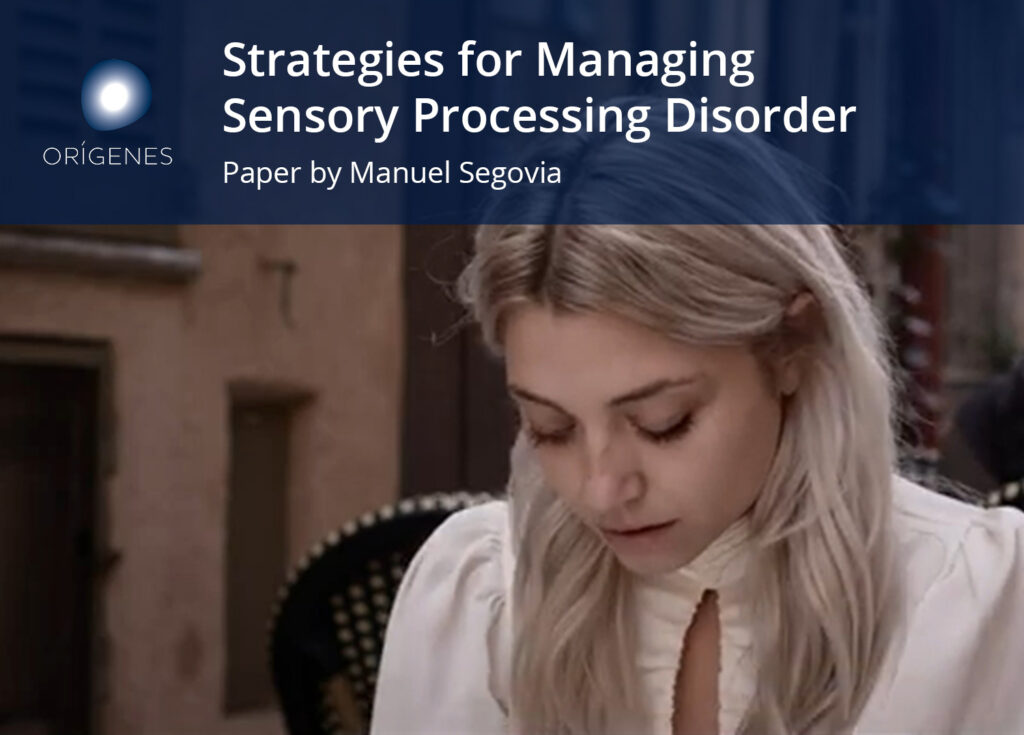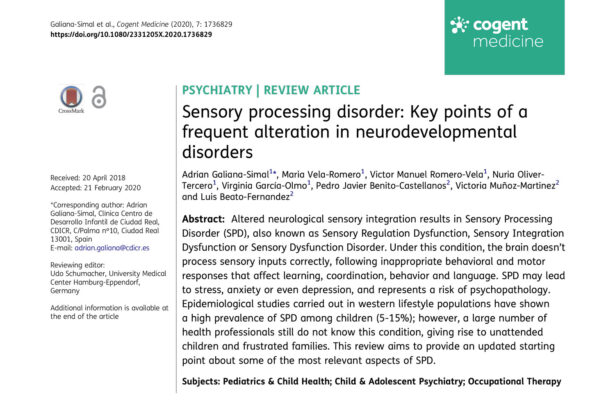
By Manuel Segovia | 13/12/24
Sensory Processing Disorder (SPD) includes a broad spectrum of issues, including sensory integration, sensory oversensitivity, sensory under-response, sensory discrimination, dyspraxia, and others. Galiana-Simai et al. 2020 presents a good description of the symptoms and characteristics of SPD and serves as our key reference for definitions related to SPD [1].
Discussions with and testimony from people affected by SPD, therapists, and caretakers make it very clear that SPD causes severe stress and anxiety. One core issue is that people affected by SPD struggle to manage the presence of groups and show a tendency toward social isolation to avoid this stress. For example, family gatherings, conferences, and other large social events are difficult. Similarly, SPD can be disabling when facing new environments.
Some additional concrete examples cited during our discussions and interviews:
- A child may face sensory overload in complex environments with a large set of sensory inputs (school, shopping centre, etc.). An episode of sensory overflow will heavily disturb the child, their caregiver, and bystanders. The time for recovery for the child can be several hours, indicating that prevention is more valuable than reacting to an episode.
- For employed adults, their daily routine will typically require facing unexpected situations and environments. For these people affected by SPD, anticipatory anxiety, aversion, and efforts to avoid certain types of sensory exposure can create chronic stress. In some cases, people affected by SPD will then systematically avoid complex or unfamiliar environments. This response will, in turn, generate social isolation and reduce their choices of profession, schooling, and social life.
- People affected by Autism Spectrum Disorder (ASD) and SPD generally need to feel in control of their environment. One common tactic is to contort into a non-ergonomic body position or add strong sounds or lights as a strategy to mask the environment. Exposure to these types of strong sensory stimuli can create long-term sensory or body-mechanical damage and can also enter into a vicious cycle by building a craving for the strong sensory stimuli.
- In extreme cases, people affected by SPD have been observed to self-harm (cutting or hitting) as one reaction to the distress and frustration of the sensory issues.
Demographics
- SPD has emerged as a significant issue as the neurodivergent population has been both growing and increasingly diagnosed [2].
- Current estimates indicate that the number of people affected by SPD is more than the combined number of people suffering from Neurodegenerative diseases as Alzheimer, dementia, and Parkinson [Autism, Alzheimer’s Statistics | Alzheimers.net].
- A large percentage of people with ASD, Attention Disorder Hyperactivity Disorder (ADHD) also have SPD [2].
- One complicating factor is that SPD is still difficult to diagnose; it is heavily related to other co-morbidities (including autism) and is often confused with several phobias.
Current Solutions
The primary existing solutions are occupational therapy and environmental adaptation or selection. Alternative sensory stimulation is an additional, but relatively under-investigated, approach.
Occupational therapy solutions aim to train the person affected by SPD to recognize and understand their trigger sensory inputs. As a result, this is normally tailored to the specific sensory needs of the subject. With richer sensory inputs (intense proprioceptive, vestibular and tactile inputs) and games, the person affected by SPD can improve the integration of their sensory inputs. While the evidence of its effectiveness varies, many individuals and practitioners report positive outcomes [3], [4].
Adapting the environment requires understanding the main sources of sensory issues and then adjusting the environment and daily routine to reduce or avoid exposure to these triggers. Examples include changing clothing materials, selecting or avoiding particular foods, and creating sensory controlled rooms. This approach seems to support better integration into society and long-term reduction of anxiety [3]. For students affected by SPD, learning outcomes are improved when the stimuli environment is controlled [5], [6].
Some evidence suggests that people affected by SPD are better able to manage natural environments [7].
One clear drawback to selecting or adjusting the environment is that these solutions may limit the environments available to those affected by SPD.
Finally, some types of sensory stimulations have been found in reported cases to calm some of the symptoms of SPD such as deep touch pressure [8] and music [9].
Conclusion
An ad hoc solution for real-time and in-situ assistance for people affected by SPD is necessary. Orígenes has the expertise, experience, and intellectual property to develop a product that significantly improves the quality of life for users. Our team includes specialists in sensory processing, electrophysiology, algorithm development, and clinical research, ensuring a comprehensive approach to addressing SPD challenges.
Our future product is intended to assist with everyday activities and improve socialization, so users experience less stress and can better manage sensory crises. We invite the neurodivergent community, potential research and industrial partners, and investors to join us in this mission to make a meaningful impact on the lives of those affected by SPD.
Bibliography
[1] A. Galiana-Simal et al., “Sensory processing disorder: Key points of a frequent alteration in neurodevelopmental disorders,” Cogent Med, vol. 7, no. 1, Mar. 2020, doi: 10.1080/2331205x.2020.1736829.
[2] N. Doyle, “Defining Neurodiversity and Identifying Neurominorities,” 2024, pp. 13–38. doi: 10.1007/978-3-031-55072-0_2.
[3] R. C. Schaaf, R. L. Dumont, M. Arbesman, and T. A. May-Benson, “Efficacy of Occupational Therapy Using Ayres Sensory Integration®: A Systematic Review,” The American Journal of Occupational Therapy, vol. 72, no. 1, pp. 7201190010p1-7201190010p10, Jan. 2018, doi: 10.5014/ajot.2018.028431.
[4] N. Pollock, “Sensory-Integration,” Occupational therapy now, vol. 10, no. 5, pp. 6–10, 2009
[5] R. Banks, “SUPPORTING GIFTED STUDENTS’ SENSORY PROCESSING THROUGH ENVIRONMENT 1 Recognizing and Modifying Environmental Factors to Support Gifted Students’ Sensory Processing in the School Environment,” 2024.
[6] H. Lonkar, “An overview of Sensory Processing Disorder,” 2014. [Online]. Available: https://scholarworks.wmich.edu/honors_theseshttps://scholarworks.wmich.edu/honors_theses/2444
[7] D. West, “Natural Learning Environments and the Social-Emotional Development of Students with Sensory Processing Challenges,” Dominican University of California, San Rafael, California, 2018. doi: 10.33015/dominican.edu/2018.edu.05.
[8] J. C. Duvall, N. Schleif, L. E. Dunne, and B. Holschuh, “Dynamic compression garments for sensory processing disorder treatment using integrated active materials,” Journal of Medical Devices, Transactions of the ASME, vol. 13, no. 2, Jun. 2019, doi: 10.1115/1.4042599.
[9] V. M. Williams, “Music Therapy and Sensory Processing Disorder in Individuals with Autism Spectrum Disorder: A Systematic Review,” Florida State University, 2020.

